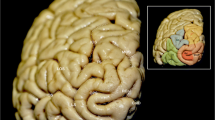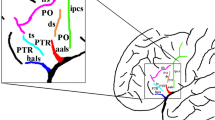Abstract
Background
Knowledge of morphology of human anterior cingulate and medial frontal cortex related to the knee of corpus callosum is important in the diagnostics and neurosurgical treatment. Neuroimaging studies did not provide a clear picture of this region, what is also caused by terminological inconsistencies. It is not always clear what is actually defined under the terms subcallosal area, subcallosal cingulate gyrus, subcallosal gyrus, subcallosal region, or subgenual prefrontal gyrus. Our study of subcallosal area provides morphological data useful for recent imaging studies.
Methods
Digital photographs (42 formaline fixed brains: 26 males, 16 females) were used in morphometry (surfaces and lengths) of subcallosal area. We defined all its boundaries: superoanterior, anterior, posterior, and inferior one. If anterior subcallosal sulcus, as anterior delineation of subcallosal area was absent, we used intercommissural line system.
Results
Anterior subcallosal sulcus we found in 86.9% of cases. Its variations were classified into four types: Type 1—vertical or slightly oblique sulcus (most often type on right hemispheres—30.1%), Type 2—in form of letter C or inverted letter C (most often type on left hemispheres—42.9%), Type 3—sulcus in form of letter S or inverted letter S, and Type 4—sulcus not belonging to any previous type. Mean surface of subcallosal area was in males 2.65 cm2 (right hemispheres), and on left 2.70 cm2. In females on right it was 2.56 cm2, and on left 2.55 cm2. All measured values were not significantly different (left/right; males/females).
Conclusions
Accurate neuroanatomical localization requires exact determination of boundaries of subcallosal area. Therefore, standardized criteria were proposed for definition of subcallosal area.








Similar content being viewed by others
References
Baare WFC, Hilleke E, Hulshoff P, Boomsma DI, Posthuma D, de Geus EJC, Schnack GH et al (2001) Quantitative genetic modeling of variation in human brain morphology. Cereb Cortex 11(9):816–824
Coryell W, Nopoulos P, Drevets W, Wilson T, Andreasen NC (2005) Subgenual prefrontal cortex volumes in major depressive disorder and schizophrenia: diagnostic specificity and prognostic implications. Am J Psychiatry 162:1706–1712
Crosby EC, Humphrey T, Lauer EW (1962) Correlative anatomy of the nervous system. Macmillan, New York, p 348
Duvernoy HM (1991) The human brain. Springer, Wien, p 19
Filimonoff IN (1949) Drevnaya, staraya i mežutočnaya kora. In: Filomonoff IN, Sarkisov SA, Preobrazhenskaya NS (eds) Citoarhitektonika kori boljšogo mozga čeloveka. Medgiz, Moskva, p 404
Federative Committee on Anatomical Terminology (1998) Terminologia Anatomica. Thieme, Stuttgart, p 126
Gittins R, Harrison PJ (2004) A quantitative morphometric study of the human anterior cingulate cortex. Brain Res 1013(2):212–222
Hamani C, Mayberg H, Snyder B, Giacobbe P, Kennedy S, Lozano A (2009) Deep brain stimulation of the subcallosal cingulate gyrus for depression: anatomical location of active contacts in clinical responders and suggested guideline for targeting. J Neurosurg 111:1209–1215
Kappers ACU, Huber GC, Crosby EC (1960) The comparative anatomy of the nervous system of vertebrates including man, vol 3. Hafner, New York, p 1592
Kilts DC, Schweitzer JB, Quinn CK, Gross RE, Faber TL, Muhammad F, Ely DT, Hoffman JM, Drexler KP G (2001) Neural activity related to drug craving in cocaine addiction. Arch Gen Psychiatry 58:334–341
Kopsch F (1943) Rauber Kopsch Anatomie des Menschen, band III. Georg Thieme, Leipzig, p 87
Kuhlenbeck H (1974) Central nervous system of vertebrates, vol 5/II. Karger, Basel, pp 58–60
Laitinen LV (1972) Stereotactic lesions in the knee of the corpus callosum in the treatment of emotional disorders. Lancet 1(7748):472–475
Mc Cormick LM, Ziebell S, Nopoulos P, Cassell M, Andreasen NC, Brumm M (2006) Anterior cingulate cortex: an MRI-based parcellation method. NeuroImage 32:1167–1175
Mühlau M, Rauschecker JP, Oestreicher E, Gaser C, Röttinger M, Wohlschläger AM, Simon F, Etgen T, Conrad B, Sander D (2006) Structural brain changes in tinnitus. Cereb Cortex 16(9):1283–1288
Ono M, Kubik S, Abernathey DC (1990) Atlas of cerebral sulci. Georg Thieme, Stuttgart, pp 33–121
Paus T, Tomaiuolo F, Otaky N, MacDonald D, Petrides M, Atlas J, Morris R, Evans A (1996) Human cingulate and paracingulate sulci: pattern, variability, asymmetry and probabilistic map. Cereb Cortex 6:207–214
Stanczyk JL (1982) Macroscopic morphology of the subcallosal area in the man and in comparative anatomy studies. Folia Morphol (Warsz.) XLI(4):429–439
Spasojević G, Malobabić S, Šuščević D, Miljković Ž (2004) Morfometrijska varijabilnost prekuneusa u odnosu na pol i hemisferu mozga čoveka. Vojnosanit Pregl 61(4):365–370
Spasojević G, Stojanović Z, Šuščević D, Malobabić S (2006) Sexual dimorphism of the human corpus calosum—digital morphometric study. Vojnosanit Pregl 63(11):933–938
Standring S (2005) In: Standring S (ed) Gray’s anatomy, 39th edn. Elsevier, Edinburgh, p 388
Talairach J, David M, Tournoux P, Corredor H, Kvasina T (1957) Atlas d’ anatomie stéréotaxique des noyaux gris centreux. Masson, Paris
Talairach J, Tournoux P (1988) Co-planar stereotaxic atlas of the human brain. Thieme, New York, p 5
Yucel K, McKinnon M, Chahal R, Taylor V, Macdonald K, Joffe R, MacQueen G (2009) Increased subgenual prefrontal cortex size in remitted patients with major depressive disorder. Psychiatry Res Neuroimaging 173:71–76
World Medical Association Declaration Of Helsinki: Ethical Principles for Medical Research Involving Human Subjects, 59th WMA General Assembly, Seoul, October 2008 Available at: http://www.wma.net/en/30publications/10policies/b3/index.html. Accessed 19 Jan 2010
Acknowledgments
This study was supported by grant Nr. 156031 of Ministry of Science and Technology of Republic Serbia.
Conflict of interest
Authors declare that they have no conflict of interest.
Author information
Authors and Affiliations
Corresponding author
Rights and permissions
About this article
Cite this article
Spasojević, G.D., Malobabić, S., Šuščević, D. et al. Morphological variability of the subcallosal area of man. Surg Radiol Anat 33, 313–318 (2011). https://doi.org/10.1007/s00276-010-0689-2
Received:
Accepted:
Published:
Issue Date:
DOI: https://doi.org/10.1007/s00276-010-0689-2




